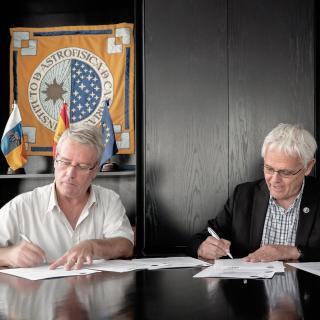It may interest you
-
 El Observatorio del Teide, del Instituto de Astrofísica de Canarias (IAC), recibió este domingo la visitas de las recién nombradas doctoras Honoris Causa de la Universidad de La Laguna (ULL), quienes pudieron conocer de primera mano cómo se trabaja en uno de los observatorios astrofísicos más importantes del mundo. La escritora Ken Bugul, la teórica de la comunicación Amparo Moreno Sardà y la historiadora de la ciencia Londa Schiebinger estuvieron acompañadas por altos cargos de la comunidad universitaria y fueron recibidas por el administrador del Observatorio del Teide, David López NespralAdvertised on
El Observatorio del Teide, del Instituto de Astrofísica de Canarias (IAC), recibió este domingo la visitas de las recién nombradas doctoras Honoris Causa de la Universidad de La Laguna (ULL), quienes pudieron conocer de primera mano cómo se trabaja en uno de los observatorios astrofísicos más importantes del mundo. La escritora Ken Bugul, la teórica de la comunicación Amparo Moreno Sardà y la historiadora de la ciencia Londa Schiebinger estuvieron acompañadas por altos cargos de la comunidad universitaria y fueron recibidas por el administrador del Observatorio del Teide, David López NespralAdvertised on -
 La viceconsejera de Planificación Territorial y Reto Demográfico del Gobierno de Canarias, Elena Zárate Altamirano, ha visitado las instalaciones del IACTEC , en el Parque Científico y Tecnológico de las Mantecas, para conocer de primera mano el proyecto European Solar Telescope (EST). Zárate se ha reunido con el equipo promotor del EST y ha recorrido las instalaciones del centro de tecnología del IAC donde están ubicados algunos de sus laboratorios de instrumentación. En la reunión han participado, entre otros, la directora técnica del proyecto Mary Barreto, la ingeniera civil YaniraAdvertised on
La viceconsejera de Planificación Territorial y Reto Demográfico del Gobierno de Canarias, Elena Zárate Altamirano, ha visitado las instalaciones del IACTEC , en el Parque Científico y Tecnológico de las Mantecas, para conocer de primera mano el proyecto European Solar Telescope (EST). Zárate se ha reunido con el equipo promotor del EST y ha recorrido las instalaciones del centro de tecnología del IAC donde están ubicados algunos de sus laboratorios de instrumentación. En la reunión han participado, entre otros, la directora técnica del proyecto Mary Barreto, la ingeniera civil YaniraAdvertised on -
 The Instituto de Astrofísica de Canarias (IAC) and the European Solar Telescope Fundación Canaria (EST-FC) have signed thos Friday October 4th the agreement to promote the construction of the European Solar Telescope (EST). This ambitious project aims to consolidate and expand the Canary Islands' position as a world leader in solar physics research. The agreement was ratified by the director of the IAC, Valentín Martínez Pillet, and the representive of EST-FC, Manuel Collados. The signing act was attended by other members involved in the project: Héctor Socas-Navarro, Alejandra Martín; andAdvertised on
The Instituto de Astrofísica de Canarias (IAC) and the European Solar Telescope Fundación Canaria (EST-FC) have signed thos Friday October 4th the agreement to promote the construction of the European Solar Telescope (EST). This ambitious project aims to consolidate and expand the Canary Islands' position as a world leader in solar physics research. The agreement was ratified by the director of the IAC, Valentín Martínez Pillet, and the representive of EST-FC, Manuel Collados. The signing act was attended by other members involved in the project: Héctor Socas-Navarro, Alejandra Martín; andAdvertised on